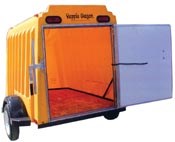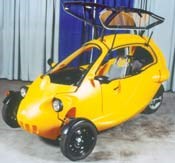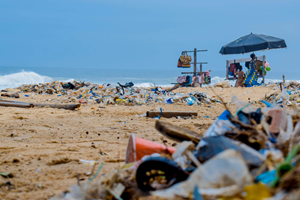Close-Up On Technology - New Technologies Add Zip to Rotomolding
Fully automated rotomolding equipment for nearly lights-out operation, a new approach to balancing molds, and a new oven design that trims space and energy requirements mark some of the new developments unveiled at the 27th Annual Fall Meeting of the Association of Rotational Molders (ARM), held in October in Toronto.
Fully automated rotomolding equipment for nearly lights-out operation, a new approach to balancing molds, and a new oven design that trims space and energy requirements mark some of the new developments unveiled at the 27th Annual Fall Meeting of the Association of Rotational Molders (ARM), held in October in Toronto. The conference and exhibition also introduced new materials technologies, including two new methods that impart adhesive qualities to polyethylene surfaces, as well as new mold coatings and release agents. A new graphic transfer technology for use in high-temperature molding environments and a one-shot foam/skin system were also unveiled.
Automation advances
The long-sought goal of fully automated rotomolding is said to be achieved by Leonardo, a new machine concept developed by Persico S.p.A. in Italy. The turnkey system is custom-designed for each user, but consistent features include pneumatically operated mold open/close movements and automated part removal and mold charging. Automation can be configured to place inserts or to charge a mold with two materials for multi-layer products.
An important aspect of the system is the machined aluminum molds designed for integral heating and cooling. Electrical resistance wires are installed in the mold for six zones of heating, while a patented internal air-cooling system is also built in. This design reduces the floor space required for the machine. The controls regulate the molding cycle via sensors that measure the internal mold temperature. They also allow the production cycle to be monitored from a PC.
Standard molds can be converted for use on Leonardo. Productivity of each mold in this system is said to equal that of four molds on a standard machine due to the close temperature control and automated handling. The carousel arrangement allows for independent operation of different molds running at the same time.
New controls and oven design for carousel and shuttle machines built by Yorke-Kann Engineering Partnership are said to trim fuel costs up to 50% while improving output by 30%. The new single-door oven design reportedly retains the heat that is usually lost when the mold enters and exits. One molder shaved its energy consumption by 33.5% with the new oven, says Yorke-Kann operations manager Tim Andregg. Oven heat-up times reportedly are as fast as 1° F/sec. PLC controls provide full recipe storage.
The goal of new software from Ferry Industries is achieving a weight balance between opposing sides of a straight arm on a rotomolding machine when each side supports molds of different weights. “If the molds on each arm do not counter-balance each other, then the gears turning the arms may wear unevenly, which could affect the molding process, not to mention machine maintenance,” says Ferry v.p. Terrance Gillian. The new software determines what weight is needed to balance the arm and where to place the weight for even counter-balancing on the major and minor axes of rotation.
Said to be an industry first, the Windows-based Automatic Arm Balancing program is an option for Ferry’s Rotocure 2000 controls. It takes readings from AC variable-speed drives used to rotate the molds and it calculates where and how much weight should be placed for balance. The program provides a graphic display of where to place the mold on the molding arm. “Molders typically balance the arms manually and would be happy if they were within 50 lb of perfect balance,” Gillian adds. The arm-balancing program is said to be accurate to ±3 lb.
Surface appeal
Two new surface-treatment approaches add paintability and adhesion qualities to polyethylene and other polyolefins. First, a new low-temperature plasma treatment for powdered or granulated resins rather than finished parts is the secret to a new line of paintable metallocene PE resins from Borealis A/S of Denmark, which plans to offer the materials here in the near future. Conventional surface treating of molded parts has a temporary effect that can fade during storage before subsequent coating or bonding, possibly resulting in later delamination or adhesion failure, according to Borealis. However, the new plasma system modifies the polymer’s chemistry from non-polar to a polar surface, and from hydrophobic to hydrophilic, “permanently altering the polymer to yield a product with higher mechanical and adhesion properties,” says Dr. Kjetil L. Borve, application marketing manager for rotational molding. Once treated, the resulting part can be stored before painting or bonding, without compromising the results. Adhesive strength is also said to be improved, allowing bonding to urethane foam or nylon, for example.
Borealis uses the plasma process on its new Paintable Borecene mPE for rotomolding, which has a density of 0.934 g/cc and an MFR2 of 6 g/10 min.
Another approach uses fluorine and combinations of other gases to modify part surfaces to accept paints, glue, or graphics. The fluorination process, called Fluoro-Prep, was developed by Fluoro-Seal. Its original use was to impart a solvent barrier to PE intermediate bulk containers (IBCs), but it is now being offered for adhesion modification of finished parts at Fluoro-Seal’s nine U.S. treatment facilities. The fluorination treatment is permanent and works on HDPE, LLDPE, PP, PC, PS, PVC, TPE, acrylic, and nylon, as well as PUR and Kevlar aramid fiber.
Graphics & coatings
High-temperature graphics suitable for transfer into molds at up to 165 F is new from Mold In Graphic Systems (MIG). The new Millennium graphic, unlike standard graphic transfers, does not require that the mold be cooled below 125 F before the graphic is applied. Millennium allows the molder to keep the tools closer to production temperature for graphic application, thereby speeding production cycles, says Scott Saxman, senior v.p. The Millennium graphic sits on a transparent film carrier that is manually placed and squeegeed onto the interior mold surface. The backing film is then peeled off, leaving the graphic in place and ready for molding.
MIG also introduced what it calls the first spray-on anti-skid product for polyolefins. MIG’s new AntiSkid requires a three-step, post-molding process. First, the mold is sprayed with a proprietary polymer-based material, which is followed by special granules or grit, then a sealing coat of the spray, and finally by flame treatment. The grit can be sand, silica, ground walnut shells, or even PE. AntiSkid eliminates the need for a textured mold.
Better releases
Maus GmbH in Germany has developed a permanent release coating that can virtually eliminate surface bubbles on parts without lengthening the process cycle. “Bubbles are a function of the material not being cured 100%,” says Sandy Scaccia, president of Norstar Aluminum Molds, which distributes the coating here. Molders typically have to extend cycle time to eliminate bubbles. The coating is a combination of PTFE and another fluoropolymer.
A new water-based, semi-permanent release for flanges and vent tubes joins the Mono-Coat line of mold-release products from Chem-Trend. Mono-Coat 1459 is a non-volatile organic compound that is liquid at room temperature.
A new mold-release coating for rotomolding polycarbonate was introduced by DuPont Coating & Release Systems. TraSys 2021 is a semi-permanent release designed to impart high-gloss surfaces, unlike typical releases for polycarbonate, which leave a matte or dull finish. The new product withstands mold temperatures up to 550 F. The solvent-based gel is said to be easy to apply.
A water-based mold cleaner and a solvent-free release that can be applied to a cold or hot mold are the latest entries for rotomolding from Zyvax Inc. Up to now, the firm has mainly served composites fabricators in the aerospace and marine industries, but it is now raising its profile in the rotomolding market. Its new Waterclean is a water-based alternative to solvent washing or sanding to clean molds, equipment, and finished parts. The material is said to be non-hazardous.
Zyvax also developed Rotoshield, a water-based (solvent-free), semi-permanent mold release for all types of PE as well as PP, nylon, and PVC plastisols. The non-flammable, heat-stable product cures fast, does not build up on the mold, and imparts high gloss and high slip/lubricity. One spray application of Rotoshield provides 10 to 50 cycles of release. It can be applied to molds from room temperature to above 140 F.
Tooling update
You can reduce mold height and eliminate the chance of losing mounting springs in the oven with a new hidden spring-mounting system from JohnDel, Inc., a four-year-old supplier of cast and fabricated molds. The new hidden spring system recesses the mounting springs inside a machined mounting post under the steel frame. Because the spring is recessed, mold height is reduced by an inch. If a mounting bolt is lost, the spring will not fall out and parting-line fit will be maintained, says Randy Johnson, president.
Starcoat, a new high-temperature mold-frame coating, is offered by Norstar Aluminum Molds to protect steel frames from rusting. Rust not only shortens the life of the frame but can also contaminate molded parts. Starcoat resists temperatures up to 2000 F.
New one-shot foam
A new one-shot foamable PE system for rotomolding was introduced by Ingenia Polymers (formerly Wedtech). Its new Rotolite OS system consists of a powdered skin material and a foamable pellet for the core. Both are dropped in the mold simultaneously. In the oven, the skin material coats the mold wall, while the foam expands to fill the interior of the part. When the foam starts to expand, the mold is removed from the oven for a room-temperature dwell cycle to complete the foaming, followed by cooling and demolding.
The skin (offered in natural, black, and white) has a tensile yield strength of 3000 psi (2200 psi at break), ultimate elongation of 800%, and flexural modulus of 106,000 psi. The foam core has a typical density of 10 pcf and compressive modulus of 1600 psi.
Related Content
Fungi Makes Meal of Polypropylene
University of Sydney researchers identify two strains of fungi that can biodegrade hard to recycle plastics like PP.
Read MoreFlexible-Film Processor Optimizes All-PE Food Packaging
Tobe Packaging’s breakthrough was to create its Ecolefin PE multilayer film that could be applied with a specialized barrier coating.
Read MoreCommodity Resin Prices Flat to Lower
Major price correction looms for PP, and lower prices are projected for PE, PS, PVC and PET.
Read MoreFundamentals of Polyethylene – Part 5: Metallocenes
How the development of new catalysts—notably metallocenes—paved the way for the development of material grades never before possible.
Read MoreRead Next
Beyond Prototypes: 8 Ways the Plastics Industry Is Using 3D Printing
Plastics processors are finding applications for 3D printing around the plant and across the supply chain. Here are 8 examples to look for at NPE2024.
Read MoreFor PLASTICS' CEO Seaholm, NPE to Shine Light on Sustainability Successes
With advocacy, communication and sustainability as three main pillars, Seaholm leads a trade association to NPE that ‘is more active today than we have ever been.’
Read MoreSee Recyclers Close the Loop on Trade Show Production Scrap at NPE2024
A collaboration between show organizer PLASTICS, recycler CPR and size reduction experts WEIMA and Conair recovered and recycled all production scrap at NPE2024.
Read More
























